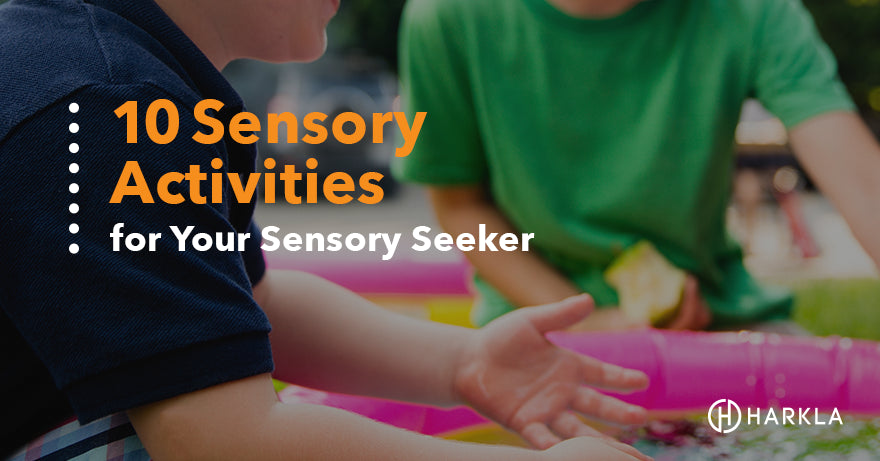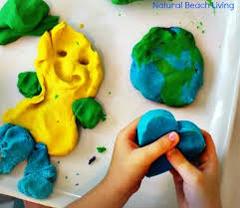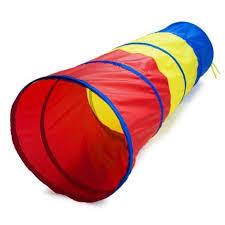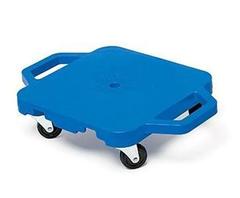Your Cart is Empty

"Sensory seeking” is an increasingly common phrase that you’ll hear teachers, parents, and pediatricians use when describing a very active child. Another term that you may hear with it is "sensory craving."
While we may hear these terms more and more often, we may not know exactly what qualifies a child to be a sensory seeker.
What makes one child more “sensory seeking” over another? What is typical sensory exploration and what sensory behaviors make adults stop and take notice? When does “sensory seeking” warrant sensory integration therapy and how can you help at home?
Children actively explore the world around them - moving, touching, and mouthing - it’s how we learn as developing humans!
The sensory stimulation that surrounds us informs how we respond. Infants, toddlers, and young developing children are allseeking sensory information because they are constantly learning through movement and sensory exploration.

Think back to your experiences with your own kids in daycare, preschool, and kindergarten. The hallmark of a great lesson plan is its multisensory design. Kids are encouraged to taste, smell, see, hear, touch, and move their bodies or objects to better understand what they are learning!
You learned about PlayDoh by squeezing, pushing, smelling, and sometimes tasting it. You explored textures by gluing, finger painting, and sandbox digging! Those sensory interactions help students take in information about what they are learning, make sense of it, and respond appropriately.
Sensory processing helps with new learning. If there is a breakdown in this process, a child may not respond appropriately to the information they are receiving. Sometimes these inappropriate responses to sensory input affect a child’s ability to participate typically in play, social situations, or new learning. This is when a sensory behavior makes an adult take notice.
In our Ultimate Guide to Sensory Processing Disorder (SPD), we talked about the three subtypes of SPD in line with the STAR Institute’s research. “Sensory seeking,” when it falls outside of typical child development, is a subtype of Sensory Modulation Disorder and is referred to as “Sensory Craving Type.”
Sensory Craving is described as when one is “driven to obtain sensory stimulation, but getting the stimulation results in disorganization and does not satisfy the drive for more” (STAR).
This sensory seeking behavior can be observed as seeking sensory input in the form of excessive:
It is important to note the difference between what is typical sensory exploration or activity and what rises to the level of significance of being sensory craving behavior. Some of this difference is accounted for by age - what is normal toddler sensory development is not typical in a seven-year-old, for example.
When clinically significant sensory craving behaviors exist, they often interfere with a child’s ability to appropriately function, attend, and interact/engage.
Also, unlike some other sensory processing disorder diagnoses, when the child receives the sensory stimulation that he seeks, it does not resolve the processing issues - in fact, it will create more disorganization.
If your child falls into this sensory craving subtype, it is best to consult your sensory integration-trained occupational therapist on an individualized sensory diet plan.
Since a child's sensory behavior is determined by their age, we've broken down our list of 10 sensory seeking activities into two different age groups.
Toddlers are at a fun age of sensory exploration. This is a play stage that emphasizes basic interactions with people and toys. Because your child’s skills are so new, they often can’t multi-task too well and keep their balance! It’s important to remember this because they’re going to want to try it all “by myself” and you want them to be set up for success.
These activities are hands-on fun with your toddler so expect to get active with them!

Crawling offers great proprioceptive input that is calming and organizing for active little bodies.
For extra sensory input, have your child wear a body sock while they crawl and wiggle through the tunnel. The body sock adds more proprioceptive input along with deep pressure input when they push and stretch against the sides.
Grab a jump rope and turn it into a limbo rope to imitate basic animal walks under it - bring on your best “bear walk” or “slithering snake” - your child will be developing motor skills and learning how to move her body in new ways just like Mom!
If you’ve got an active toddler, try shaking the rope low to the ground and see if she can jump, step, or walk over it without touching the “snake!”
“Finger painting” with sand, rice, actual finger paints, and even chocolate pudding make for hands-on fun to draw shapes, explore textures, and develop early visual-motor skills. These activities are great for kids who like to touch and seek out tactile sensory input. Add a smell or taste component to the finger painting to offer additional sensory stimulation.
Toddlers haven’t yet mastered jumping with 2 feet by themselves, but take hold of their hands and practice on a bouncy mattress, soft couch, or mini-trampoline.
Put on some music and do the freeze dance - jumping style! Try and jump for a whole song - a nursery rhyme or kids’ song will challenge their endurance for longer lasting vestibular input.
Whether they’re hitting a balloon with their hands or a styrofoam paddle, kids are challenging their vestibular, balance, and visual-motor skills to keep the balloons from hitting the ground.
Every time he bends down to pick up the balloon or looks up at the balloon in the air, your child is changing his head position - which means an extra dose of vestibular stimulation! Try batting the balloon with an adult or give kids a paddle for an extra challenge or two!
Preschoolers are proud of their newfound skills and increasing independence! Choose activities that introduce multi-tasking: gross motor and cognitive or social challenges. Involve a peer to challenge your child’s problem solving and social skills too.

If you’re lucky enough to have a playroom, dedicated kid-zone, or garage space, a scooter is an indoor play favorite. Kids can create obstacle courses, race a friend on a chalk-drawn track, or zoom like a rocket ship!
On bellies, on knees, or even on their backs, kids can meet their vestibular and proprioceptive needs while working on upper body and core strength.
Pinterest is a great resource for scooter activities – everything from whole-body bowling to scooter board Hungry Hungry Hippos!

In our home, the playground activity we miss the most in the winter is the swing. If you’ve got a doorway, you can install an indoor pod swing for the kids who need a stronger dose of vestibular input on a more regular basis.
Another option when looking for an indoor swing is a compression swing. A compression swing provides a hug-like feeling along with vestibular input. It has amazing effects on a sensory-seeker!
One of the versatile favorites (but requires adult supervision) is an exercise ball. We all have one somewhere in the house with the best of intentions to work on our own core strength… but consider repurposing it for the kids this winter.
Bounce them on it and sing a song, roll them over it on their bellies to put together a puzzle, roll upside-down to pick up blocks, squish them underneath to make a kid sandwich, or push it through a tunnel! If you have a hippity hop, kids can jump themselves too! The possibilities are endless but remember that an adult needs to supervise this activity.

Use your jump rope for some jumping games! Can you jump side to side? Zigzag? Bunny hop across? Up and back?
Your preschooler is learning to take more risks in his gross motor play, so challenge his endurance with some new jumping ideas.
For more jump rope games, check out this list from The Inspired Treehouse. If your child isn't ready for a jump rope, try the same games with a hula hoop!
Your preschooler likely can jump on his own by now, so use your mini trampoline to jump and catch/throw, jump and crash into soft pillows or bean bag chair, and jump for sustained amounts of time.
Jumping is a great way to get vestibular and proprioceptive input while also building endurance. If your mini trampoline has a handle, be mindful of very active jumpers as they may easily flip the trampoline as they get bigger and more competent.
Kids learn through moving and move to learn, so some element of seeking sensory information is part of a typical childhood.
Some children with sensory processing disorder have sensory needs that rise to the level of impacting their ability to function, interact, or attend appropriately. These warrants more specific sensory diet planning with close supervision and consultation with an occupational therapist.
For the rest of the active kids out there, sensorimotor activities can be part of a general “sensory diet” to promote regulation and organization throughout the day.
Try engaging your active child in some of these fun activities and let us know what your favorites were!
Any help for a 7 year old?
Hey Tammy, Vanita, and Jimmy,
Thanks for your feedback! We’re glad you got some helpful info from our article about sensory seeking behavior and activities to help!
All the best,
Nicole
Harkla Happiness Ninja
I am a special school administrator here in Lagos Nigeria and we have quite a number of our pupils who manifest series of sensory seeking behaviours. i must confess this has helped greatly especially here that materials are very limited. i will appreciate if more materials available.
I need so much help with learning how to effectively assist my grandson who has SPD. He and his mother has been living with me for the past 2 years and my home went from calm to chaotic. The good news is that, he read at the age of 2. I want to help him have a better academic and social life. I want to learn as much as possible about this disorder which will in turn help me advocate on his behalf.
Fantastic take on a lot of sensory seeking issues our 3 year old has right now. We live in an apartment and it is just the three of us in the evenings and on weekends. I am thinking about getting an indoor trampoline to help him with some of it. Most of his issues is with rubbing our arms or legs to find “boo boos”, scabs or imperfections to rub on. When does this become more of a problem or another issue that we need to seek out help for?
Comments will be approved before showing up.


Kidskastle Preschool
February 25, 2025
This article provides fantastic insights into sensory-seeking activities! 🌟 The practical strategies and engaging ideas make it easier for parents and caregivers to support children with sensory needs. I love how it emphasizes fun and development together. Thank you for sharing such valuable information.